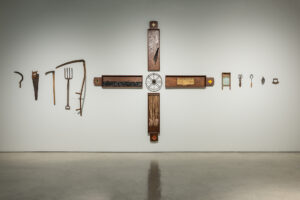The Awkward Moments are images of everyday contemporary life and historical events familiar to Canadians. They represent historical figures, celebrated personalities, pop culture characters, and the general public absorbed in social activities (such as fishing, camping and skating) that tell the stories of the Canadian nation. On the surface, the images are amusing – they appear to engage in harmless parody of a people focused on daily mundane pursuits. In so doing they bring to the fore issues that are unpleasant and uncover a ‘reality’ of the Canadian condition that is not all perfect. The very same images that boast native pride are also marred by references to identity crisis, social anxiety and apathy, existential absurdity, environmental destruction, and human propensity to violence.
The Awkward Moments are also fraught with contradictions and forced ambiguity. They oscillate between fact and fiction, child-play and adult situations, comedy and tragedy. The juxtapositioning of the iconic works of the Group wiht the kitsch-like dioramas create disruptive tension within the photographs. The landscape paintings of the Group provide a historical context for the theme of national and cultural identity, and a link to past or common ideological constructs of Canadianism. Over the course of the twentieth century these historical paintings have come to signify the Canadian identity through their connection to the land. Thorneycroft’s appropriation of the historical paintings as backgrounds to images reflecting tainted and banal realities removes them from their original idealized context, thus deconstructing not only their established myth but that of the nation they symbolise.
Curated by Sharona Adamowicz-Clements
The McMichael Canadian Art Collection






